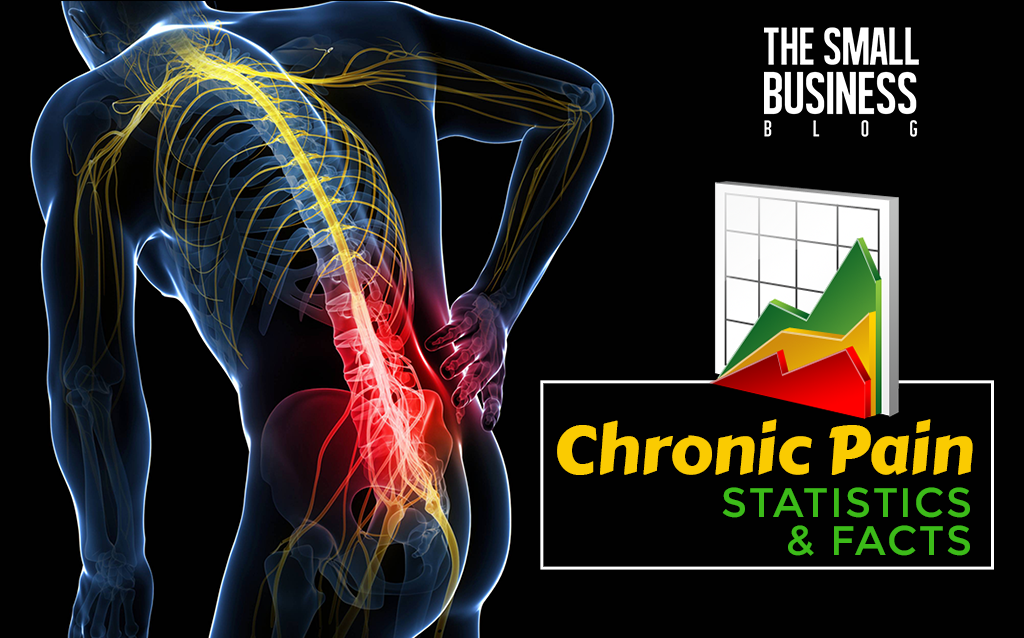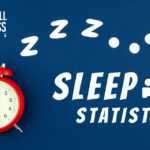Chronic pain is hard to bear. But, if you have chronic pain, know that millions of people worldwide understand what it feels like and are here for support.
The National Institute of Neurological Disorders and Strokes explains how acute pain differs from chronic: “Acute pains come on suddenly while they last; whereas with Chronic Pain persists because the nervous system keeps firing.”
Chronic pain is a debilitating condition that affects many people.
The statistics for chronic pain are astounding, and you should know them if you or someone close to you suffers from this ailment.
This chronic pain statistics guide for 2024 will go over some of the essential numbers and facts about chronic pain in America and the world today.
Post Contents
- 1 Key Chronic Pain Statistics 2024
- 2 Interesting Facts about Chronic Pain
- 2.1 1. Chronic Pain Could Linger for Six Months or More.
- 2.2 2. About 11% to 40% of Adults Live with Chronic Pain.
- 2.3 3. In 2016, 1 out Of Every 5 Adults in The US Experienced Chronic Pain.
- 2.4 4. More Americans Suffer from Chronic Pain Compared to Cancer, Diabetes, and Heart Disease Combined.
- 2.5 5. There Are Four Common Types of Chronic Pain: Lower Back Pain, Migraine/severe Headache, Neck Pain, and Facial Pain.
- 2.6 6. About 22% and 19% of Women and Men Respectively Report Suffering from Chronic Pain.
- 2.7 7. The Chance of Chronic Pain Experience Increases as You Get Older.
- 2.8 8. About 30% of Adults Aged 65 and Above Experience Chronic Pain.
- 2.9 9. Most Adults Seek Medical Attention Because of Chronic Pain.
- 3 The Costs of Chronic Pain
- 3.1 1. The U.S. Spends $635 Billion on Chronic Pain Annually. the Health Economist Arrived at This Figure by Breaking Down the Increasing Worth of Health Care Resulting from Pain and The Target Worth Resulting from Lower Productivity.
- 3.2 2. Missed Productiveness Resulting from Chronic Pain Leads to Spending $299-$344 Billion in The U.S.
- 4 Global Chronic Pain Statistics 2024
- 5 The Statistics On Chronic Pain Effects
- 5.1 1. Roughly About 25% of Those Suffering from Chronic Pain Will Develop Chronic Pain Syndrome (CPS).
- 5.2 2. Victims of Chronic Pain Experience at Least a 42-Minute Sleep Deficit Daily.
- 5.3 3. About One out Of Every Four People Suffering from Chronic Pain Are Clarified with Sleep Diseases.
- 5.4 4. Not Less than 85% of Chronic Pain Patients Are Stirred by Terrible Depression.
- 5.5 5. The Figure of Patients Who Commit Suicide Because of Chronic Pain Increases from 7.4% to 10.2% Between 2003 and 2014.
- 5.6 6. Among the Deceased, the Most Popular Conditions Were;
- 6 Handling Chronic Pain
- 6.1 Opioids
- 6.1.1 1. The United States Gave About 191 Million Opioids Pills to Victims in 2017.
- 6.1.2 2. Alabama State Inscribes Three Times More Opioid Medications Individually than Hawaii.
- 6.1.3 3. Patients with Chronic Non-Cancer Pain (CNCP) of About 20% Receive an Opioid Recommendation when They See a Physician.
- 6.1.4 4. About One-Third of Prescriptions Are for Patients Over 65.
- 6.1.5 5. 30% of Admitted Elders Can Be Linked to A Severe Drug-Related Circumstance or Harmful Impact from Sedatives and Opioids.
- 6.1.6 6. A Report in 2016 Shows that Over 11.5 Million US Citizens Report the Misuse of Prescription Opioids.
- 6.2 Here’s the Real Deal:
- 6.1 Opioids
- 7 Exercise
- 8 Physical Therapy
- 9 Chiropractor
- 10 Cognitive Behavioral Therapy (CBT)
- 11 Other Ways of Dealing with Pain
- 12 Final Notes
- 13 Sources
Key Chronic Pain Statistics 2024
- Chronic pain can last for six months or more
- There are four main types of chronic pain
- Your chances of experiencing chronic pain increase with age
- Most adults need medical attention for chronic pain
- 10% of people in the world experience chronic pain
- Chronic pain victims get 42 less minutes of sleep a day
- Overdose kills more American than guns
Interesting Facts about Chronic Pain

Here we made a compilation of statistics on chronic pain to help you know the gravity of the problem:
1. Chronic Pain Could Linger for Six Months or More.
For those who experience chronic pain, it is not just the original injury or illness feeling discomfort.
The Institute of Chronic Pain explains how someone experiences an initial bout with acute pain and then starts experiencing recurring episodes regularly; this constitutes being diagnosed with chronic pain.
Worryingly for many sufferers in America, “chronic” can mean anything from constant to intermittent pains without any chance at recovery – which means that some people are living each day under intense physical duress.
At the same time, others might only suffer mild aches now and again after lifting something heavy one too many times throughout their lifetime.
2. About 11% to 40% of Adults Live with Chronic Pain.
3. In 2016, 1 out Of Every 5 Adults in The US Experienced Chronic Pain.
Millions of Americans suffer from debilitating chronic pain.
In addition, 8% describe their condition as ‘high-impact, defined by life or work activities being limited on most days in the past six months.
4. More Americans Suffer from Chronic Pain Compared to Cancer, Diabetes, and Heart Disease Combined.
5. There Are Four Common Types of Chronic Pain: Lower Back Pain, Migraine/severe Headache, Neck Pain, and Facial Pain.
6. About 22% and 19% of Women and Men Respectively Report Suffering from Chronic Pain.
The statistics prove that women show more likelihood to get down with chronic pain compared to men.
7. The Chance of Chronic Pain Experience Increases as You Get Older.
| PERCENT OF CHRONIC PAIN IN ADULT | ||
| Age Group | Chronic pain | High-impact chronic pain |
| 18-24 years | 7.0 | 1.5 |
| 25-44 years | 13.2 | 4.4 |
| 45-64 years | 27.8 | 12.0 |
Several factors determine the chance of experiencing chronic pain.
Some of these include employment status, where you live, gender, and social status. The table highlights some of the differences.
8. About 30% of Adults Aged 65 and Above Experience Chronic Pain.
9. Most Adults Seek Medical Attention Because of Chronic Pain.
The pain is also linked to limitations in daily activity, mobility, anxiety, poor sensed health, dependence on opioids, or decreased quality of life.
There also spreads some ugly information for youthful readers and their parents.
10. Globally, 20% to 40% of adolescents and children suffer chronic pains.
Most times, they suffer from conditions such as abdominal pain, headaches, and musculoskeletal pain.
With time, their relatives might go through emotional discomfort.
According to research, the response given to a child’s pain could have a notable effect on the reasons behind the child’s pain.
The Costs of Chronic Pain
Just as expected, the population of people suffering chronic pain hurts the economy.
1. The U.S. Spends $635 Billion on Chronic Pain Annually. the Health Economist Arrived at This Figure by Breaking Down the Increasing Worth of Health Care Resulting from Pain and The Target Worth Resulting from Lower Productivity.
This annual worth exceeds that of diabetes, heart disease, and cancer.
2. Missed Productiveness Resulting from Chronic Pain Leads to Spending $299-$344 Billion in The U.S.
Most adults who suffer from chronic pain have their annual income reduced due to missed days from the office.
Global Chronic Pain Statistics 2024
1. Not Less than 10% of The Globe Is Touched by Chronic Pain.
Roughly, that’s about 60 million of the world population seeking ease from pain.
2. Globally, $77.8 Billion Is Spent on Treating Chronic Pain.
According to marked estimate predictions, the stated figure may increase yearly by 6.5%.
3. About 25% of The Globe Is Undergoing Chronic Pain in Low Countries.
Developing countries suffer more cases of chronic pain, contrary to the wealthy nations.
The Statistics On Chronic Pain Effects

Chronic pain could be dominating. It causes trouble sleeping and is capable of leading to suicide. The statistic is chilling;
1. Roughly About 25% of Those Suffering from Chronic Pain Will Develop Chronic Pain Syndrome (CPS).
According to the Neurology department of Columbia University, those with CPS display symptoms more than pain, depression, anger, lack of sexual drive, anxiety, and disability that interfere with daily lives.
CPS also occurs with other conditions with long-term pain like stroke, chronic fatigue syndrome, cancer, inflammatory bowel disease, endometriosis, and fibromyalgia.
2. Victims of Chronic Pain Experience at Least a 42-Minute Sleep Deficit Daily.
The National Sleep Foundation on American conducted a Sleep Poll, which reflects that pain comes with a substantial challenge regarding adequate night sleep.
The findings seem worrisome because Americans are not great sleepers by nature.
A report of ‘very good’ or ‘good’ sleep quality comes from 65% of the U.S. population. In contrast, just 37% complain of chronic pain.
3. About One out Of Every Four People Suffering from Chronic Pain Are Clarified with Sleep Diseases.
Sleep diseases are increasing globally and giving more concern to those suffering from chronic pain.
4. Not Less than 85% of Chronic Pain Patients Are Stirred by Terrible Depression.
Clinical studies have proven that people affected by chronic pain mostly have depression.
According to the World Health Organization, over 264 million patients are presently suffering from depression.
5. The Figure of Patients Who Commit Suicide Because of Chronic Pain Increases from 7.4% to 10.2% Between 2003 and 2014.
Research has it that pain conditions increase suicidal tendencies.
In the space of 11years, the National Violent Death Reporting System specified that 8.8% (10,789) of suicidal attempts could be linked to chronic pain.
16.2% of patients who committed suicide passed on due to opioid overdose.
6. Among the Deceased, the Most Popular Conditions Were;
- Diabetes (4.9%)
- Fibromyalgia(5.1%)
- Migraine (5.2%)
- Arthritis (7.9%)
- Cancer (12.5%)
- Injury (13.2%)
- Back pain (22.6%).
Handling Chronic Pain

Chronic pain conditions need life-long management.
The short video outlined by the American Chronic Pain Association offers vital takeaway messages: handling pain is more than just treatment.
It entails a corporate effort with those in distress, leading an essential role to live to term.
Let’s consider some popular relief choices for people suffering from chronic pain.
Opioids
According to the Mayo Clinic point of view, opioids are a pain-relieving drug brand that helps communicate with your cell’s opioid receptors, repress your pain perception, and increase your feelings of delight.
Even as we learn, there are issues with the U.S. which need consideration before snatching them.
1. The United States Gave About 191 Million Opioids Pills to Victims in 2017.
Primary health givers are worried about patient’s obsession. They have pointed out limited training regarding the use of opioids.
2. Alabama State Inscribes Three Times More Opioid Medications Individually than Hawaii.
Research shows that regional changes in the prescription of opioids use can’t be linked to the fundamental health status of those living there.
3. Patients with Chronic Non-Cancer Pain (CNCP) of About 20% Receive an Opioid Recommendation when They See a Physician.
This statistic is chilling; since the use of opioids in treating CNCP reveals no positive effect and does not boost the patient’s life quality.
4. About One-Third of Prescriptions Are for Patients Over 65.
The American Chronic Pain Association said harmful repercussions from drugs for those above 65s are mostly neglected to be age-related transformations ( stomach upset, dizziness, and general weakness).
Also, it can imply the patient is having a medication-related issue.
5. 30% of Admitted Elders Can Be Linked to A Severe Drug-Related Circumstance or Harmful Impact from Sedatives and Opioids.
6. A Report in 2016 Shows that Over 11.5 Million US Citizens Report the Misuse of Prescription Opioids.
Here’s the Real Deal:
7. Overdose Kills More Americans than Gun Violence Crimes.
A shocking study reveals that more people in the United States died of drug overdoses last year than during any armed conflict since World War II.
In 2017, over 70,000 Americans lost their lives to this epidemic.
Unfortunately, these numbers keep rising each passing day because synthetic opioids like fentanyl have been getting into America’s drug supply at record rates.
The CDC has issued a warning about how devastating opioid addiction can be, but unfortunately, not many are heeding it; as long as there is money involved, someone will always take advantage for profit, so we must do what we can on an individual level to help end this terrible crisis before it becomes too late.
8. Daily, 90 Americans Die Prematurely Due to Opioid Overdose.
This affects all socio-demographic groups, but those within the low economic group are more vulnerable.
Exercise

The release of endorphins has proven to be a natural painkiller.
Research also shows that exercise can help ease back and joint pain long-term, improving muscle tone, strength, and flexibility.
For example, one study in 2015 discovered how engaging in pilates reduced chronic low back pain more than any other intervention using minimal physical exercises.
In addition, walking may come with added benefits such as improving blood flow which could reduce the risk or delay Alzheimer’sAlzheimer’s disease, among many others.
Physical Therapy

Physical therapy is a game-changer in the way that people deal with pain.
Rather than being reliant on opioid prescriptions, physical therapists can find and treat the root of your chronic aches while also coexisting as a holistic approach for those who’re feeling overworked or depressed.
Chiropractor

Chronic back pain?
Consider seeing a chiropractor. The Harvard Medical School says that these medical professionals often use spinal manipulation to correct the body’s alignment to relieve you of your debilitating chronic back pains.
This technique has shown positive results, according to research conducted by the American Chiropractic Association.
In addition, it is not as risky as some other treatment options for lower back pain–the risks are relatively low.
Cognitive Behavioral Therapy (CBT)

You may not think cognitive-behavioral therapy (CBT) is for you if you live with chronic pain, but it can be a powerful tool to help reduce stress and improve your mental health.
It has been found that CBT can have tremendous benefits when applied in the context of chronic pain patients – one study shows up to 85% improvement after six months!
The ACPA notes how “pain-CBT” takes care of emotional needs and physical ones, so they work together instead of aggravating each other.
The skills learned from this type of treatment include identifying negative thoughts that only make things worse or creating more constructive coping strategies like exercise routines tailored to those who suffer from persistent discomfort every day.
Other Ways of Dealing with Pain
Since chronic pain is a long-term condition, it’s essential to find ways of managing and treating it.
Journaling can help with that process by keeping track of your symptoms, what you do each day, and any foods consumed.
It also provides valuable records for both the sufferer and their doctor, leading to more effective treatments being discovered later on down the line.
Another technique worth trying would be acupuncture; studies have shown this has two benefits: an increased tolerance threshold for discomfort or pain in some cases and relief from chronic pain over time if practiced regularly.
Vitamin D has been on the rise as a potential weapon against chronic pain.
A study by the National Institutes of Health found that daily supplementation with vitamin D can help to alleviate bone health and joint pain, especially in cases like arthritis or other types of persistent ailments.
The research also suggests that this may be an essential part of prevention- so it’s vital not just to cure your chronic condition but do all you can to make sure it doesn’t reoccur!
While there is no conclusive evidence yet about how exactly Vitamin D helps relieve these symptoms, researchers are optimistic due to its connections within cellular activities thought protective from developing such problems again down the line.
Final Notes
Chronic pain is a severe problem that impacts many people of all ages.
The chronic pain statistics in 2024 that we’ve provided show just how widespread chronic pain has become in the United States and worldwide, but they also reveal factors that may make some individuals more susceptible to developing chronic pain than others.
It can be challenging for chronic pain sufferers to know where to turn when it seems like no one understands what you are going through, so don’t hesitate to reach out if you need support or information about your condition.
You deserve better treatment options!






























